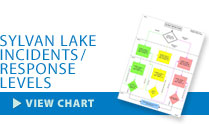Sylvan Lake EAP Case Study
The Dam Owner's Perspective
The initiative by the District leadership to have an IEAP for Sylvan Lake Dam was an outgrowth of some of the safety and water handling improvements in the 1990s. DNR engineers suggested that an IEAP would be an important step to demonstrate concern for public safety. Conservancy Board Secretary Leigh Ann Pranger attended a DNR dam safety workshop that stressed the importance of emergency planning.
"The District board decided to do an action plan because of the HHP status of the dam and all the homes downstream," said Ms. Pranger, who also is Town Manager for Rome City. "We also wanted to have an inundation map to go along with the plan. Siavash helped create the state's IEAP template and is familiar with the state trust lakes and their dams. I don't recall any issues or problems as we developed the IEAP. There was some disagreement about when to activate the Tainter gate, but we are on site and able to watch situations develop so we determined the appropriate conditions that would trigger using the gate."
There were some initial conflicting priorities among some departments of the state government, she said, with conservation officers worried about environmental damage if water is released from the dam to relieve pressure, while others insist this is a small price in comparison with not releasing water and risking a breach that could be deadly and devastate homes, businesses and property. Overall, Ms. Pranger said, the IEAP process went smoothly because "Everybody had the same thought process and mindset" about what were the objectives and needed to be included in the IEAP.
Ms. Pranger said that the time and resources required for the IEAP preparation were not a significant burden on the District. The technical data about the dam and its operation in an emergency were developed by Siavash. The other crucial aspect of creating a viable and complete IEAP was the participation of a dedicated local Emergency Management Director (EMD), who developed the notification sequence and first responder actions for the various levels of incident/emergency, identified staging areas for supplies, and coordinated with other emergence response agencies.
"The inundation map told us how much time the areas below the dam had to evacuate, and when we turned that over to the emergency manager, he and the sheriff took care of the evacuation plans and other emergency response aspects," she said. "It matters who you get in that position. Our county emergency manager is active, and when the IEAP was put together the evacuation plan was not included. We left that up to the sheriff, but he has a lot of other things going on, and when there is an incident our District people have to be at the dam not downstream working evacuations. So our emergency manager took up the evacuation planning and worked out all the details.
"There are a lot of infrastructure issues as well. For example, the state highway runs through the area of the dam. As dam owners and part of the Rome City community, there is comfort just in knowing that everything basically is mapped out, including why and when to open the gate. If the water reaches a pre-determined height where we have to let some water out, we can do it gradually as determined in the IEAP. While there will be flooding issues, we can avoid the velocity issues of a dam failure."
In the years since the IEAP was created there has not been an emergency situation that resulted in opening the Tainter gate, she said. But in some years there have been heavy rains and area flooding that have led to activation of the IEAP to monitor the pressures on the dam. These incidents have proved the value of having the incidents and corresponding response procedures spelled out in the IEAP.
"We had issues in 2008 when there was a big August storm that hit Lagrange a few miles north of Sylvan Lake with more than 15 inches of rain. We got the tail end of it, fortunately," Ms. Pranger said. "We would have to open the gate if we got that much water. Other years we've had heavy spring rains that triggered the IEAP, and once in the winter the ground was so frozen the water couldn't soak in, so we had to watch the lake and dam closely.
She said the District board has found that creating an IEAP provides an invaluable public safety tool, but it must be regularly updated, tested, and become a "living" document that accommodates change.
"We have IEAP tabletop exercises every three years to test the plan assumptions and implementation," she said. "Our emergency manager and IEAP exercise facilitator haver created scenarios that are really challenging and involve problems we hadn't fully considered – various types of mechanical malfunctions, traffic accidents on the highway, and the need to always designate back-up people knowledgeable about the dam and the IEAP for those frequent occasions when someone is out of town. We have learned very important information from these exercises."
Who gets called first when an incident develops was changed from the initial version of the IEAP, which in turn changed the flow of notification and response to better fit the local procedures and responsibilities. That was an important and necessary modification that was spotted by the Noble County Emergency Management Director, Michael "Mick" Newton.



